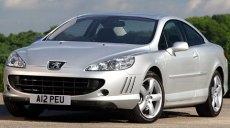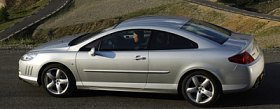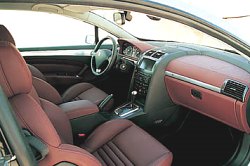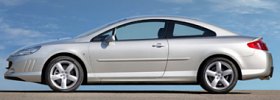|
 The
Pininfarina-designed 406 Coupe was one of my all-time favourite
designs, otherwise I would not have used it as the icon of Super
Gallery. Today, Pininfarina studio has lost the magic – see last year's
Peugeot 1007 and you will know. No wonder Peugeot decided to design
most cars by itself. Unfortunately, neither can Peugeot itself draw a
design as beautiful as the 406 Coupe. When I first saw the 407 Coupe,
it did catch my eyes with its mini-Ferrari profile. Simultaneously, it
has strong resemblance to its predecessor at side profile and
especially C-pillars. Nevertheless, a closer look reveal that the
profile is somewhat wrong - isn't that front overhang too long? Isn't
the laughing grille too exaggerate? the details also lack finesse, e.g.
the black bumper in front grille is flawed, the rear lights could be
more elegant… This means while the design of 407 Coupe is eye-catching,
it is not time-resisting. The
Pininfarina-designed 406 Coupe was one of my all-time favourite
designs, otherwise I would not have used it as the icon of Super
Gallery. Today, Pininfarina studio has lost the magic – see last year's
Peugeot 1007 and you will know. No wonder Peugeot decided to design
most cars by itself. Unfortunately, neither can Peugeot itself draw a
design as beautiful as the 406 Coupe. When I first saw the 407 Coupe,
it did catch my eyes with its mini-Ferrari profile. Simultaneously, it
has strong resemblance to its predecessor at side profile and
especially C-pillars. Nevertheless, a closer look reveal that the
profile is somewhat wrong - isn't that front overhang too long? Isn't
the laughing grille too exaggerate? the details also lack finesse, e.g.
the black bumper in front grille is flawed, the rear lights could be
more elegant… This means while the design of 407 Coupe is eye-catching,
it is not time-resisting.
 The 407 Coupe is naturally a
derivative of the 407 Sedan. They share the same 2725 mm wheelbase, but
the footprint is different. After installing that long long shark nose,
the Coupe found itself being 140 mm longer than the sedan. However, by
reducing ride height and dropping the roof by 45 mm, center of gravity
is lowered by a healthy 25 mm. At the same time, the width is stretched and the tracks are widened
by 23 mm front and 46 mm rear. All these points to improved cornering
stability. Besides, the 2-door body is 8 percent stiffer than the
sedan, with a torsional rigidity at 24,582 Nm / degree. Moreover, the
suspensions got electronic adaptive damping to aid handling. The 407 Coupe is naturally a
derivative of the 407 Sedan. They share the same 2725 mm wheelbase, but
the footprint is different. After installing that long long shark nose,
the Coupe found itself being 140 mm longer than the sedan. However, by
reducing ride height and dropping the roof by 45 mm, center of gravity
is lowered by a healthy 25 mm. At the same time, the width is stretched and the tracks are widened
by 23 mm front and 46 mm rear. All these points to improved cornering
stability. Besides, the 2-door body is 8 percent stiffer than the
sedan, with a torsional rigidity at 24,582 Nm / degree. Moreover, the
suspensions got electronic adaptive damping to aid handling.
 Many French cars today have one
common problem: overweight. The 407 Coupe is no exception. Without
seeking weight saving from lightweight materials, the car is 150 kg
heavier than its predecessor engine by engine. That means the 3.0 V6
weighs a hefty 1612 kg, while the 2.7 V6 turbo diesel with compulsory
Tiptronic automatic gearbox even tips the scale at an astonishing 1724
kg ! The petrol 407 Coupe continues to use the 211 hp 3.0 V6 and 160 hp
2.2 inline-four from its predecessor. As a result, performance is
actually deteriorated. While 406 Coupe 3.0 V6 could accelerate from 0
to 60 mph in 7.5 seconds, the equivalent 407 Coupe does that in 7.9
seconds, even though it is lifted by a 6-speed manual gearbox. Many French cars today have one
common problem: overweight. The 407 Coupe is no exception. Without
seeking weight saving from lightweight materials, the car is 150 kg
heavier than its predecessor engine by engine. That means the 3.0 V6
weighs a hefty 1612 kg, while the 2.7 V6 turbo diesel with compulsory
Tiptronic automatic gearbox even tips the scale at an astonishing 1724
kg ! The petrol 407 Coupe continues to use the 211 hp 3.0 V6 and 160 hp
2.2 inline-four from its predecessor. As a result, performance is
actually deteriorated. While 406 Coupe 3.0 V6 could accelerate from 0
to 60 mph in 7.5 seconds, the equivalent 407 Coupe does that in 7.9
seconds, even though it is lifted by a 6-speed manual gearbox.
This
make the twin-turbo 2.7-litre diesel V6 more appealing. On the one
hand, the Ford-PSA co-developed unit is actually quieter than the
slightly groovy petrol V6 (as I mentioned before, it is probably the
best diesel V6 in the world). On the other hand, its combination of 324
lbft of torque and 204 horsepower output delivers better real-world
performance than the petrol V6. Moreover, it suits the character of the
car – like its predecessor, the 407 Coupe is not an exciting driver's
car, but a comfortable, stress-free coupe.
 Like its predecessor, the 407
Coupe intends to be a genuine 4-seater coupe. To some extent this
target is accomplished, as it provides decent legroom and headroom the
rear passengers. However, those admired 406 Coupe could be disappointed
that the new car, despite of its increased size and weight, actually
offers slightly less rear seat room. It once again proves that
Peugeot's own designers are not good at packaging efficiency. Like its predecessor, the 407
Coupe intends to be a genuine 4-seater coupe. To some extent this
target is accomplished, as it provides decent legroom and headroom the
rear passengers. However, those admired 406 Coupe could be disappointed
that the new car, despite of its increased size and weight, actually
offers slightly less rear seat room. It once again proves that
Peugeot's own designers are not good at packaging efficiency.
Predictably, the dashboard architecture is the
same as 407 sedan to save cost, but in V6 models the cabin ambience is
greatly
lifted by red leather trim, which clad the bucket seats, door panels,
instrument binnacle and glovebox area. The alloy decoration also
enhances the delicious feel.
On
motorway, the 407 Coupe is a fine long distance traveler, thanks to
refined ride, stable body control and the general lack of noise. Turn
it into fast bends, the car displays terrific stability and grip,
thanks to the double-wishbone suspensions which keep the front wheels
perpendicular to the tarmac. As its cornering limit is unusually high
for a front-drive machine, you need to push it very hard to see it
understeer, and then ESP cut in.
 Nevertheless, the driving
experience is
not very engaging. The steering is not as feelsome as the old car, especially when
the nose is burdened by the diesel V6. The brake pedal also lacks feel.
The acceleration is not strong enough to ignite excitement. The
Tiptronic gearbox reacts slowly to human inputs…. On bumpy surfaces,
its firm suspensions fail to filter the bumps, even in Comfort
mode. Switch to Sport mode and the ride could be unacceptably harsh.
This means the 407 Coupe prefer wide open highways than narrow country
roads. What a difference from its supple-riding predecessor.... Nevertheless, the driving
experience is
not very engaging. The steering is not as feelsome as the old car, especially when
the nose is burdened by the diesel V6. The brake pedal also lacks feel.
The acceleration is not strong enough to ignite excitement. The
Tiptronic gearbox reacts slowly to human inputs…. On bumpy surfaces,
its firm suspensions fail to filter the bumps, even in Comfort
mode. Switch to Sport mode and the ride could be unacceptably harsh.
This means the 407 Coupe prefer wide open highways than narrow country
roads. What a difference from its supple-riding predecessor....
Perhaps the most hurting is that it still trails the 406 Coupe in
design, packaging, performance and ride, even though it is 8 years
younger. This proves how great the 406 Coupe was, and how difficult for
its successor to run out of its shadow. |